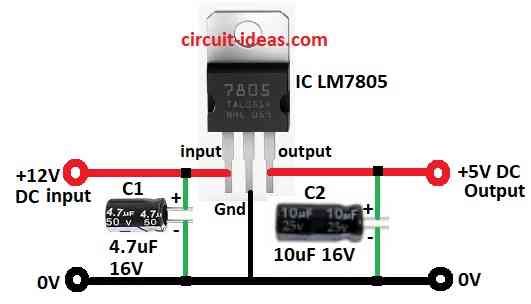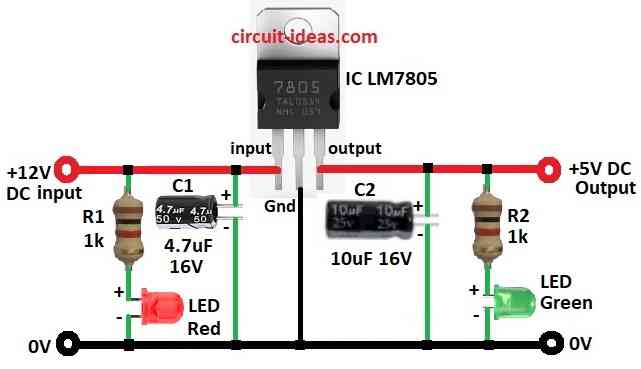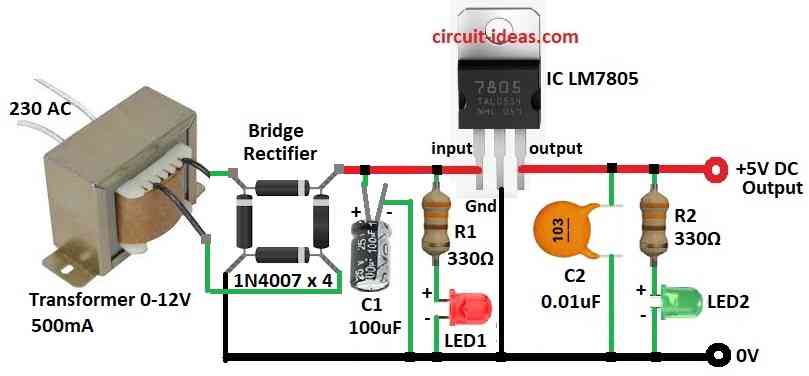Stable 5V power needed for many electronics like sensors, microcontrollers and digital parts.
LM7805 voltage regulator IC is used in 12V to 5V converter which is very useful.
This circuit takes 230V AC and gives 5V DC and keeps device working good and stable.
Main parts of the circuit are transformer, bridge rectifier, filter capacitors, resistors and LEDs.
Transformer drops 230V AC to 12V AC.
Bridge rectifier makes AC to DC and capacitors of 100µF/25V and 0.01µF smooth the DC.
LM7805 makes this DC steady 5V for device use.
Two 330Ω resistors used for red and green LEDs to stop extra current and show power status.
Simple circuit work well and are good for many electronic projects.
Next we will see 3 Ways to Build a 12V to 5V Converter Circuit using IC LM7805 which will explain working, formulas and how to make process.
Circuit Working:



Parts List for all three circuit diagram:
| Component Type | Description | Quantity |
|---|---|---|
| Resistors | 330Ω 1/4 watt | 2 |
| 1k 1/4 watt | 2 | |
| Capacitors | Electrolytic 100µF/25V,10µF 16V, 10µF 16V | 1 each |
| Ceramic 0.01µF | 1 | |
| Semiconductors | IC LM7805 | 1 |
| Transformer 230V to 0-12V AC | 1 | |
| Bridge Rectifier Module 1N4007 | 4 | |
| LED Red 5mm 20mA | 1 | |
| LED Green 5mm 20mA | 1 |
IC 7805 comes in many shapes and can use on prototype board or PCB easily.
Now we make 5V DC regulator from start.
7805 is good choice as it gives 5V from 12V to 35V DC input and max current is 1.5A.
It has 3 pins: input, ground and output.
Need to add right capacitors for stable input and output.
Heat is sink often needed to remove extra heat.
All 3 circuits do the same job.
First circuit connect between 12V DC supply and 5V device.
Second circuit shows when voltage is present.
Third circuit shows AC to DC 5V regulated power supply.
We can use as stand alone 5V source.
Formulas:
Below are formulas for 3 types of LM7805 circuits.
LM7805 Circuit with LEDs:
To find LED current use ohms law.
Red LED drop (Vf) = 2V and Green LED drop = 2.2V.
Formulas:
Red LED: IR1 = (Vin − Vf) / R1
Green LED: IR2 = (Vout − Vf) / R2
Each part and formula helps with voltage control, less noise, LED shows status and better circuit stability
We must know these things to build good working circuits.
How to Build:
3 Ways to Build a 12V to 5V Converter Circuit using IC LM7805 follow the below mentioned steps:
Connect IC 7805:
- Input pin to +12V DC
- GND pin to GND
- Output pin to +5V DC
Add capacitors:
- C1 4.7µF from +12V to GND
- C2 10µF from +5V to GND
Second Circuit:
- Same as first circuit
Add LEDs and resistors:
- R1 1kΩ + Red LED in series from +12V to GND
- R2 1kΩ + Green LED in series from +5V to GND
Third Circuit:
- R1 330Ω + Red LED1 in series from +12V to GND
- R2 330Ω + Green LED2 in series from +5V to GND
Add capacitors:
- C1 100µF +12V to GND
- C2 0.01µF +5V to GND
Connect bridge rectifier:
- Positive terminal goes to 7805 input
- Negative terminal goes to GND
- AC terminals goes to 12V output from transformer
Conclusion:
This post for 3 Ways to Build a 12V to 5V Converter Circuit using IC LM7805 fits many PCB types and are good for making 5V DC regulator.
Works from 12V to 35V input and gives stable 5V output.
It is useful for powering devices, showing voltage or giving stand alone 5V source.
Using heat sinks and right capacitors makes it more stable and reliable.
Leave a Reply